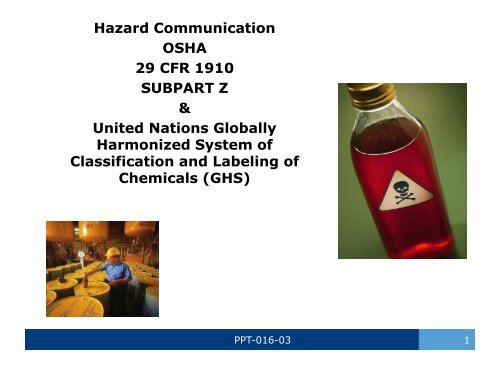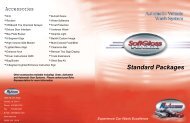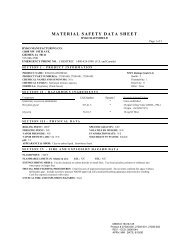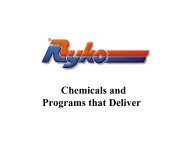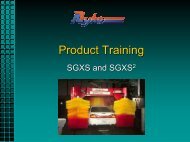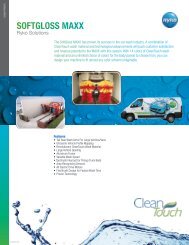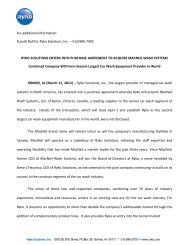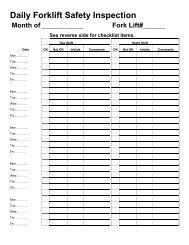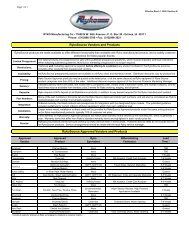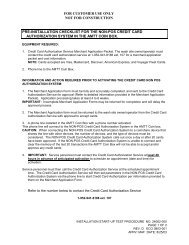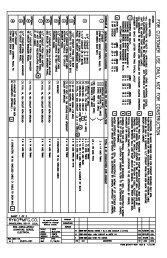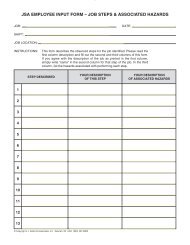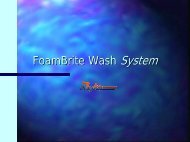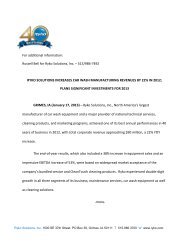Hazcomm GHS Ryko Presentation - Ryko Manufacturing
Hazcomm GHS Ryko Presentation - Ryko Manufacturing
Hazcomm GHS Ryko Presentation - Ryko Manufacturing
You also want an ePaper? Increase the reach of your titles
YUMPU automatically turns print PDFs into web optimized ePapers that Google loves.
Hazard Communication<br />
OSHA<br />
29 CFR 1910<br />
SUBPART Z<br />
&<br />
United Nations Globally<br />
Harmonized System of<br />
Classification and Labeling of<br />
Chemicals (<strong>GHS</strong>)<br />
PPT-016-03 1
Intent - To provide employees with information<br />
to help them make knowledgeable decisions<br />
about chemical hazards in their workplace<br />
PPT-016-03 2
Standard Requirements<br />
• Written program for each location to cover issues<br />
of chemical safety and hazard communication<br />
(HAZCOMM)<br />
• Labels to identify each chemical<br />
• Material Safety Data Sheets (MSDSs) (now SDSs<br />
under the Globally Harmonized System: <strong>GHS</strong>)<br />
• Safe work procedures/practices<br />
• Employee training on SDS information and safe<br />
chemical procedures and practices<br />
PPT-016-03 3
Training<br />
• Upon initial employment<br />
• When a new hazardous<br />
product/chemical is introduced<br />
into the workplace<br />
• Change in process<br />
• As deemed necessary by<br />
supervision/management<br />
PPT-016-03 4
“Right to Know” Law<br />
• Ensures all employees’ right to know the hazards<br />
of chemicals they work with at their job<br />
• Mandates that employees must be provided with<br />
information about chemicals they work with<br />
through:<br />
o Information on chemical labels<br />
o Safety Data Sheets (SDSs)<br />
o Training on hazard communication<br />
o Written HAZCOMM plan<br />
PPT-016-03 5
Why is a Standard Necessary?<br />
• To evaluate the hazards of all chemicals imported into,<br />
produced, or used in workplaces in the United States<br />
• To prevent or minimize employee exposure to chemicals<br />
• Because chemical exposure can contribute to serious<br />
health effects:<br />
o Heart ailments<br />
o Burns/rashes<br />
o Kidney/lung damage<br />
o Sterility<br />
o Cancer<br />
o Central nervous system damage<br />
PPT-016-03 6
Globally Harmonized System<br />
“Globally Harmonized<br />
System” created by the<br />
United Nations<br />
Also known as “<strong>GHS</strong>”<br />
A system for<br />
standardizing chemical<br />
classification and<br />
labeling for world-wide<br />
implementation<br />
Labels:<br />
Signal words<br />
(Danger/Warning)<br />
Hazard statements<br />
Precautionary<br />
statements<br />
Pictograms (9)<br />
SDS-16 categories<br />
Training<br />
PPT-016-03 7
<strong>GHS</strong><br />
Rationale:<br />
“To provide a single, harmonized system to classify<br />
chemicals, labels and SDS with the primary benefit<br />
of increasing the quality and consistency of<br />
information provided to workers, employers and<br />
chemical users”*<br />
Effective, in part, on June 26, 2012, with a built-in<br />
transition period and a fully effective date of<br />
June 1,2016<br />
*Ruth Mayo, EHS Today, “<strong>GHS</strong>: The Power of One,” December 1, 2009<br />
PPT-016-03 8
OSHA HazComm Modifications due to <strong>GHS</strong><br />
o Hazard classification of chemical hazards<br />
o Revised labeling provisions that include<br />
requirements for:<br />
• Standardized signal words<br />
• Pictograms<br />
• Hazard statements<br />
• Precautionary statements<br />
o Specified format for safety data sheets in 16<br />
section format and<br />
o Revisions to definitions of terms used in the<br />
standard and requirements for employee training<br />
on labels and Safety Data Sheets (SDS)<br />
PPT-016-03 10
HCS Key Revisions also Include<br />
• Disclosure of PELs and voluntary threshold limit values (TLVs)<br />
established by the American Conference of Governmental Industrial<br />
Hygienists (ACGIH)<br />
• Disclosure of carcinogen status from nationally and internationally<br />
recognized lists of carcinogens<br />
• Inclusion of combustible dust in the definition of “hazardous<br />
chemical” covered on labels and SDS<br />
• Workers be re-trained within 2 years of the publication of the final<br />
rule<br />
• Mixtures (<strong>GHS</strong>)<br />
o Health hazards can be based on data for mixture<br />
o If no data, extrapolate from ingredient data or other similar mixtures<br />
to classify<br />
PPT-016-03 11
HNOC: Hazards Not Otherwise Classified<br />
• Creation of a new category of hazards – “Hazards Not Otherwise<br />
Classified” (HNOC)<br />
• OSHA originally classified this category<br />
• HNOC (HCS) disclosed on SDS in section 2, not label<br />
• Under new <strong>GHS</strong> standard, the following are not classified under<br />
HNOC but addressed individually:<br />
o Pyrophoric gases<br />
o Simple asphyxiants<br />
o Combustible dusts<br />
• <strong>GHS</strong> label elements for combustible dusts:<br />
o Signal Word: Warning<br />
o Hazard Statement: “May form combustible dust concentrations in the air”<br />
PPT-016-03 12
Other Label Elements<br />
OSHA label elements for:<br />
Pyrophoric Gases:<br />
-Signal Word: Danger<br />
-Hazard Statement: “Catches fire spontaneously if<br />
exposed to air”<br />
Simple Asphyxiants:<br />
-Signal Word: Warning<br />
-Hazard Statement: “May displace oxygen and cause<br />
rapid suffocation”<br />
Combustible Dusts:<br />
-Signal Word: Warning<br />
-Hazard Statement: “May form combustible dust<br />
concentrations in the air”<br />
PPT-016-03 13
OSHA<br />
OSHA proposed all revisions of the Hazard<br />
Communication Standard (HCS) become effective<br />
by June 1, 2016<br />
PPT-016-03 17
Hazard Classification<br />
• <strong>GHS</strong> has specific criteria for each health and<br />
physical hazard<br />
• Detailed instructions for hazard evaluation and<br />
determinations whether mixtures of the substance<br />
are covered<br />
• A and B (mandatory): Classification guidance for<br />
health hazards and physical hazards<br />
• Test-method neutral (person classifying a chemical<br />
or substance should use available data and no<br />
additional testing is required to classify a chemical)<br />
PPT-016-03 18
Hazard Classification<br />
<strong>GHS</strong>: Only terminology changes<br />
<strong>GHS</strong> has no provisions regarding<br />
Hazard Communication programs<br />
PPT-016-03 19
Hazard Communication & Chemical Safety<br />
Chemicals are all<br />
around us every day<br />
Chemicals can be:<br />
o Corrosive<br />
o Reactive<br />
o Flammable<br />
o Explosive<br />
o Oxidizing<br />
o Inert<br />
PPT-016-03 20
Chemical Safety<br />
In many cases, the chemicals you may deal with<br />
at work are no more dangerous than those you<br />
use at home<br />
But in the workplace exposure may be greater,<br />
concentrations higher, exposure time longer:<br />
potential danger could be greater on the job<br />
PPT-016-03 21
Routes of Occupational Exposure<br />
Inhalation - nearly all materials that are airborne<br />
can be inhaled<br />
Skin Absorption - skin contact with a substance<br />
can result in a possible reaction<br />
Ingestion - most workers do not deliberately<br />
swallow materials they handle<br />
Injection – normally associated with bloodborne<br />
pathogens<br />
Ocular - absorbed through the eyes<br />
PPT-016-03 22
Hazards<br />
A chemical can pose a “physical hazard” or a “health<br />
hazard”<br />
The hazard communication standard applies to both<br />
types of hazards<br />
<strong>GHS</strong> looks at:<br />
o Class-nature of hazard<br />
o Category-degree of<br />
severity<br />
PPT-016-03 23
Physical Hazards<br />
Physical hazards are exhibited by certain<br />
chemicals because of their physical properties<br />
(e.g. flammability, reactivity, etc.)<br />
These chemicals fall into the following classes:<br />
o Flammable liquids or solids<br />
o Combustible liquids<br />
o Compressed gases<br />
o Explosives<br />
PPT-016-03 24
Physical Hazards<br />
• Organic peroxide: May react explosively to<br />
temperature/pressure changes<br />
• Oxidizers: Chemicals that initiate or promote<br />
combustion in other materials<br />
• Pyrophoric materials: May ignite<br />
spontaneously in air temperatures of 130ºF<br />
or below<br />
• Unstable materials<br />
• Water reactive materials<br />
PPT-016-03 25
Health Hazard<br />
Health hazard - Occurs when a chemical<br />
produces an acute or chronic health effect on<br />
exposed employees<br />
PPT-016-03 26
Acute Health Effects<br />
• Happen quickly<br />
• High, brief exposure<br />
• Examples:<br />
o Carbon monoxide<br />
poisoning<br />
o Cyanide inhalation<br />
o Hydrogen sulfide<br />
inhalation<br />
PPT-016-03 27
Chronic Health Effects<br />
• May be caused by chemical exposures that do<br />
not cause immediate, obvious harm or make<br />
you feel sick right away<br />
• May not see, feel, or smell the danger<br />
• Effects are long, continuous and follow<br />
repeated long-term exposure; e.g.:<br />
o Lung cancer from cigarette smoking<br />
o Black lung from coal mine dust<br />
PPT-016-03 28
Keeping It Safe<br />
• Corrosives, solvents and other chemical<br />
substances can be potentially dangerous<br />
• Safe handling procedures<br />
o Read container labels<br />
o Check SDS(s)<br />
• Never sniff a chemical for identification<br />
• Use appropriate personal protective equipment<br />
PPT-016-03 29
Labeling<br />
Example of one type of<br />
labeling system used<br />
PPT-016-03 30
Chemical Labels<br />
• Each container must be<br />
labeled, tagged or marked<br />
• Warning can be a message,<br />
words, pictures or symbols<br />
• Labels must be written in<br />
English and prominently<br />
displayed<br />
PPT-016-03 31
Label Information<br />
Chemical manufacturers and importers must<br />
provide a label that includes:<br />
• Harmonized signal word<br />
• Pictogram<br />
• Hazard statement for each hazard class<br />
and category<br />
• Precautionary statements must also be<br />
provided as well as product identifier and<br />
supplier information<br />
PPT-016-03 32
Reading Chemical Labels<br />
Warning labels provide important information about<br />
the chemical:<br />
DANGER<br />
WARNING<br />
Always read the label before you begin a job using<br />
a potentially hazardous chemical<br />
If you see the words<br />
“Warning or “Danger”,<br />
they are considered<br />
Hazardous Chemicals.<br />
PPT-016-03 33
Labeling<br />
Employers who only store chemicals may either<br />
use OSHA’s new labeling system or continue<br />
using the NFPA 704 rating system or HMIS<br />
system<br />
(OSHA plans to change the labeling system June 1, 2016)<br />
PPT-016-03 35
<strong>GHS</strong> Comparison<br />
<strong>GHS</strong> classification ratings order of severity differ<br />
from NFPA and HMIS:<br />
HMIS/NFPA<br />
0 = Least Hazardous<br />
4 = Most Hazardous<br />
<strong>GHS</strong><br />
5 = Least Hazardous<br />
1 = Most Hazardous<br />
PPT-016-03 36
Pictograms<br />
Different symbol on<br />
white background with<br />
red square frame set on<br />
point<br />
Eight pictograms are<br />
required by OSHA<br />
The ninth one dealing<br />
with the environment<br />
is not within OSHA’s<br />
jurisdiction<br />
PPT-016-03 37
Health Hazard<br />
Used to describe:<br />
o Carcinogen<br />
o Mutagenicity<br />
o Reproductive toxicity<br />
o Respiratory sensitizer<br />
o Target organ toxicity<br />
o Aspiration toxicity<br />
o Germ cell mutagens<br />
PPT-016-03 38
Flame<br />
Describes:<br />
o Flammables<br />
o Pyrophorics<br />
o Self-heating<br />
o Emits flammable gas<br />
o Self-reactives<br />
o Organic peroxides<br />
PPT-016-03 39
Exclamation Mark<br />
Describes:<br />
o Irritant (skin and eye)<br />
o Skin sensitizer<br />
o Acute toxicity (harmful)<br />
o Narcotic effects<br />
o Respiratory tract irritant<br />
o Hazardous to ozone layer<br />
(non-mandatory)<br />
PPT-016-03 40
Gas Cylinder<br />
Describes:<br />
o Gases under pressure<br />
PPT-016-03 41
Corrosion<br />
Describes:<br />
o Skin corrosion/burns<br />
o Eye damage<br />
o Corrosive to metals<br />
PPT-016-03 42
Exploding Bomb<br />
Describes:<br />
o Explosives<br />
o Self-reactives<br />
o Organic peroxide<br />
PPT-016-03 43
Flame Over Circle<br />
Describes:<br />
o Oxidizers<br />
Anything wrong<br />
with this picture?<br />
Yes!<br />
Unsafe storage –<br />
cylinders falling over!<br />
PPT-016-03 44
Skull and Crossbones<br />
Describes:<br />
o Acute toxicity (fatal or toxic)<br />
PPT-016-03 45
Signal Word<br />
A single word<br />
indicating relative<br />
hazard severity<br />
“Danger” for more<br />
severe hazards,<br />
“Warning” for less<br />
severe hazards<br />
PPT-016-03 46
Labels<br />
Information required on<br />
a <strong>GHS</strong> label:<br />
1-Product identifier<br />
2-Pictograms<br />
3-Signal word<br />
4-Hazard statement<br />
5-Precautionary statement<br />
6-Supplier information<br />
PPT-016-03 49
Labels<br />
Chemical manufacturer,<br />
importer or distributor:<br />
ensure each container<br />
of hazardous chemicals<br />
leaving workplace is<br />
labeled, tagged or<br />
marked with:<br />
o Identity of chemical,<br />
o Hazard warnings, and<br />
o Name and address of<br />
manufacturer, distributor<br />
or importer<br />
PPT-016-03 54
Transporting<br />
For transportation:<br />
Use pictograms, referred<br />
to as labels in transport<br />
regulations, prescribed by<br />
UN Model Regulations on<br />
the Transport of<br />
Dangerous Goods<br />
PPT-016-03 55
Dangerous Good Label<br />
UN regulations:<br />
This symbol affixed to<br />
packaging on a<br />
background of<br />
contrasting color<br />
Only UN transport<br />
markings and labels are<br />
required for outer<br />
packaging<br />
PPT-016-03 56
Label Examples<br />
On containers<br />
On shipping boxes<br />
PPT-016-03 57
Intermodal Container Markings<br />
“Hazard Identification<br />
Numbers” may be used<br />
with intermodal<br />
containers<br />
Top panel: 2 or 3 digits<br />
coded to group of<br />
hazards;<br />
Highly flammable<br />
liquid<br />
Gasoline<br />
Bottom panel: these<br />
numbers can be searched<br />
in the Emergency<br />
Response Guidebook<br />
PPT-016-03 58
SDS<br />
• Under the <strong>GHS</strong>, MSDSs<br />
(material safety data sheets)<br />
become SDS (safety data sheets)<br />
• Categories (16) to be listed in a<br />
specific order<br />
• Adheres to ANSI standard Z400.1<br />
• <strong>GHS</strong> requires new SDSs be in<br />
uniform format by June 1, 2015<br />
• Information for mixtures not<br />
individual chemicals in a mixture<br />
PPT-016-03 59
SDS (formerly MSDS)<br />
• Safety Data Sheet<br />
• Developed by chemical<br />
manufacturers and<br />
importers<br />
• An SDS must be on hand<br />
for each hazardous<br />
chemical used<br />
• SDS for mixtures not<br />
individual chemicals in<br />
the mixtures<br />
PPT-016-03 60
Information on a SDS<br />
• Chemical names<br />
• Manufacturer info (name,<br />
address and telephone<br />
numbers)<br />
• List of chemical ingredients<br />
• Permissible exposure limits<br />
(PELs) and threshold limit<br />
values (TLVs)<br />
PPT-016-03 61
Information on a SDS<br />
Any other exposure limit used<br />
or recommended by chemical<br />
manufacturer, importer or<br />
employer preparing the SDSs<br />
now are required on the SDS<br />
PPT-016-03 62
SDS Categories<br />
Section 1: Identification<br />
Section 2: Hazard identification<br />
Section 3: Ingredients<br />
Section 4: First-aid measures<br />
Section 5: Fire fighting measure<br />
Section 6: Accidental release measures<br />
Section 7: Handling and storage<br />
PPT-016-03 65
Information on a SDS<br />
• Reactions with other chemicals<br />
• Physical appearance<br />
• Date of preparation<br />
• Plus:<br />
o How to put out a fire caused by a<br />
chemical<br />
o How to handle spills<br />
o How to prevent dangerous exposures<br />
PPT-016-03 63
SDS Categories<br />
Section 8: Exposure controls and personal protection<br />
Section 9: Physical and chemical properties<br />
Section 10: Stability and reactivity<br />
Section 11: Toxicological information<br />
Section 12: Ecological information*<br />
Section 13: Disposal considerations*<br />
Section 14: Transport information*<br />
Section 15: Regulatory information*<br />
Section 16: Other information<br />
*OSHA indicated that since other agencies regulate sections 12-15, OSHA will<br />
not be enforcing them<br />
PPT-016-03 66
Where are your SDSs?<br />
SDSs:<br />
• Must be readily accessible<br />
to employees during their<br />
work shift<br />
• Are typically kept in a<br />
centralized location<br />
• Must be updated as new<br />
information becomes<br />
available<br />
PPT-016-03 64
Location of MSDS/SDS’S<br />
AVAILABLE<br />
ONLINE ONLY<br />
•Each workstation in plant<br />
•Lotus Notes-Safety Section<br />
•Old station and books in plant<br />
will be removed<br />
PPT-016-03 70
Finding Our SDS’s<br />
• Go to Human Resources<br />
• Open Safety Section<br />
• Click on MSDS<br />
• Or you may have a shortcut already<br />
installed on your computer<br />
PPT-016-03 71
Lotus to MSDS Website<br />
PPT-016-03 72
Performing A Search<br />
Enter Chemical Name or<br />
Product Number. Click on<br />
search button. Results<br />
will be displayed.<br />
PPT-016-03 73
Chemicals Not in Our Library<br />
• Click on “MSDSonline Search”<br />
• Enter the chemical name in the box<br />
• The search will look through millions of MSDS’s to find a match<br />
• This feature is incredibly helpful to technicians in the field dealing with<br />
strange chemicals at worksites<br />
PPT-016-03 87
Written HAZCOMM Plan Should Include<br />
• How SDS filing requirements are being met<br />
• Type of labeling system being used<br />
• Detailed information on training and<br />
compliance<br />
• Methods to inform you of non-routine tasks<br />
and safe procedures<br />
• Methods to inform outside contractors of the<br />
HAZCOMM program<br />
PPT-016-03 88
Summary<br />
• All facilities should have a hazard<br />
communication plan in a location that is<br />
accessible to all employees<br />
• All hazardous products should be labeled and<br />
all employees should be aware of what and<br />
where they are<br />
• SDSs should be available and accessible for all<br />
hazardous products<br />
PPT-016-03 94
Now that You’ve Been Through the <strong>Presentation</strong>:<br />
Do you see any problems here?<br />
Large<br />
containers<br />
balanced<br />
on edge of<br />
shelf- not<br />
safe<br />
If chemical,<br />
coffee can is<br />
not proper<br />
type of<br />
storage<br />
container<br />
Maybe improperly labeled container- what’s in the coffee can?<br />
Coffee not allowed with chemicals; if chemical, not labeled properly<br />
PPT-016-03 95
Questions<br />
PPT-016-03 96


